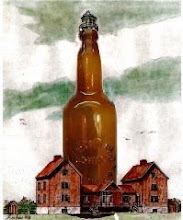The old beer-tapping prank: One strong hit on the top of an open beer bottle, and poof! Your IPA explodes into a brewski volcano.
"In one second, most of your beer has really turned into foam," says Javier Rodriguez Rodriguez, assistant professor at the Fluid Mechanics Group of Carlos III University in Madrid. "You better have put the bottle into your mouth, because you need to drink whatever is coming out."
Physicists know quite a bit about beer foam, Rodriguez says. They've pinpointed the components of barley and wheat that make a fluffy, thick head. And they've explained why the bubbles in Guinness sink instead of rise. But the tapping phenomenon has been a long-standing puzzle in beer science ? until now. Rodriguez and his team have figured out that a stiff hit on the bottle's top sets off miniature explosions inside the beer. These tiny blasts create mushroom clouds similar to those generated in the air by an atomic bomb, the Salt reported. "Actually, the laws of physics that control the development of these beer mushroom clouds are the same as [those that drive] the development of the cloud in an atomic bomb," Rodriguez says. "Obviously, there's no nuclear stuff in the beer. So the source of the explosion is very different, but the mushroom cloud that you see is very similar."
Rodriguez presented his findings at the end of November at a scientific meeting in Pittsburgh. But the idea for the project started where all good beer research does - at a pub. He and a bunch of scientists went to a bar one night after work, when one of their friends fell victim to beer tapping. "We asked ourselves, what was the cause for this?" Rodriguez says. "So we decided to go to the lab and do some experiments under well-controlled conditions." They started filming the process in the lab with high-speed cameras. And eventually, the team realized that bottle tapping set off a chain reaction in the beer ? a bit like a Rube Goldberg device. The end result was a mushroom cloud of beer. But the steps in between are a bit more complicated.
Step 1: Throbbing bubbles
A swift strike on the bottle's mouth sends waves down through the liquid. The waves cause tiny bubbles in the beer to pulsate. They shrink and swell. The glass bottle may seem solid, but it can act like a spring, Rodriguez says. "So when you hit the spring, [the glass] compresses and creates waves. From a mathematical point of view, it's like a sound wave traveling through in the beer."
Step 2: The collapse
At some point, the bubbles just can't take the compression anymore. The force becomes too much for the gaseous pockets, and they shatter - very quickly. "The bubbles collapse violently," Rodriguez explains. "They break up into clouds of tiny fragments - and in very little time." (Physicists call this process cavitation.)
Step 3: The rise
Here's where the magic starts happening.
The tiny fragments of bubbles start to grow very rapidly. "The carbon dioxide has an easier time to get into the bubbles because of the increase in surface area," Rodriguez says. "So they grow very, very fast." As they grow, they become lighter and lighter. So they start to rise. "It's like a spot of hot air in the environment," he says. "The bubbles are buoyant and will rise."
Step 4: The eruption
Now the reaction has reached the point of no return. "The faster the bubbles rise, the faster they grow, because the mixing with carbon dioxide is more efficient," Rodriguez says. And that creates a self-feeding loop: The bubbles keep growing and rising, faster and faster. Ultimately, the loop becomes so intense that plumes or mushroom clouds of bubbles form in the beer. The result is foam spewing out of the beer bottle in a few hundred milliseconds, Rodriguez says. "There's really not much you can do to stop it."
All right, so the end result of all this research is that, sadly, you can't save your beer from the evils of tapping. But Rodriguez and his colleagues are now studying whether their findings may have applications beyond the bar.
For example, there have been instances when large amounts of carbon dioxide have suddenly erupted from lakes and volcanoes. "Some geologists think that our findings could have technological applications to prevent these incidents - or even [for] carbon dioxide sequestration," he says.
Who knows? Maybe the science of beer tapping could one day prove useful in the fight against climate change. www.belgianshop.com




No comments:
Post a Comment